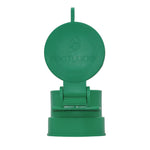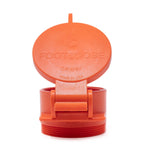You have no items in your shopping cart.
Well-sealed pipes are among the fundamental building blocks of any plumbing system. Tight pipe connections ensure water, natural gas, or compressed air – all generally referred to as “fluid” – can travel safely from one place to another.
The ability to reliably seal a threaded pipe is one of the basic skills every plumber has to possess. It’s also an important skill for housebuilders, campground owners, and DIY construction enthusiasts of all kinds.
Almost all plumbing systems contain threaded pipes. These pipes fit easily into one another with threaded male and female connections, much like wood screws. Pipes designed to carry the flow of fluids typically feature a tapered point. In the United States, the specifications for this point are defined by the National Pipe Taper standard.
Which Types of Pipe Threads Need Sealant?
Unlike parallel threads, tapered threads are slightly smaller in circumference at the end of the tapered male insert. This ensures that the pipe connection can safely carry fluid without leaking. However, these joint assemblies cannot achieve a watertight seal on their own. Tapered threaded connections need sealant to guarantee a long-lasting seal.
Non-tapered threaded connections are not commonly found in residential applications in the United States. These thread connections rely on gaskets or O-rings to prevent leakage.
There is a national standard for tapered pipe fittings that does not require sealants. This is the Dryseal American National Standard Taper Pipe Thread. These pipes are usually found in industrial pipe systems designed to transport fuel, so you’re unlikely to see them in residential use.
How to Select a Good Thread Sealant
Since tapered pipe threads feature small voids between threads when connected, they need a malleable substance to fill that extra space and prevent leakage. Thread sealant tape is one of the most popular tools plumbers use to achieve this.
There are multiple types of thread sealant tapes available on the market. Manufacturers make tapes out of various materials, with different thicknesses for specific applications. In order to pick the right sealant tape, you must identify the application you want to use it for first.
- Standard sealant tape is corrosion- and acid-resistant. This is the ideal sealant tape for water system connections, including potable and non-potable water. Standard sealant tape is made of polytetrafluoroethylene, also called PTFE.
- White high-density tape is colored white. It’s useful for industrial applications with strict non-contamination standards. You’ll find this tape in the food manufacturing and processing industry, as well as hospitals and pharmaceutical labs.
- Pink plumbing tape is slightly heavier and more robust than standard thread sealant tape. It is designed for high-performance plumbing applications where high water pressures may compromise weaker fittings.
- Yellow gas line tape fits specific gas company standards designed to ensure the safe operation of hydrocarbon fuel lines. This kind of tape has industrial and home use applications, including butane and propane lines for gas grills and kitchen equipment.
- Green oxygen tape is grease-free and non-combustible, making it ideal for oxygen applications. This type of sealant tape is commonly found in healthcare environments as well as industrial settings.
- Grey stainless steel tape has nickel pigmentation added to the tape, which prevents galling and seizing when used on stainless steel pipe fittings. This is a high-density tape used for heavy-duty industrial and agricultural applications.
How to Use Pipe Sealant Correctly
Forming a hermetic seal with pipe sealant is simple. The process only takes a few steps:
- Hold the male-threaded pipe in one hand and the spool of pipe sealant tape in your other.
- Wrap the spool of tape around the pipe thread, going in the same direction as the thread.
- For most pipes, you should only need to wrap the thread two or three times to achieve a tight grip.
- Insert the male-threaded pipe into the female-threaded joint assembly and start twisting it shut.
- Tighten the threaded joint one or two turns beyond finger tightness.
Pipe Sealant Mistakes to Watch Out For
While pipe sealant is easy to understand and use, inexperienced plumbers and constructors can still make mistakes. Make sure you pay close attention to these common mistakes people make when attempting to seal their first pipes.
- Don’t Overwrap the Pipe Thread. If you use too much tape, the sealant will wedge between threads. This increases the amount of stress the joint assembly is under, which may eventually lead to leaking.
- Don’t Wrap the Female Pipe Thread. Trying to wrap the female pipe thread will also cause wedging and compromise the strength of the joint assembly.
- Be Aware of Tape Thickness. While most tape and pipe-thread combinations will seal effectively with two or three wraps, this is not a hard-and-fast rule. Thinner tape may require four or five turns to generate a tight seal.
- Don’t Over Tighten the Joint. If you tighten a threaded joint more than two turns beyond finger tightness, you may cause the joint to warp over time, which will eventually cause a leak.
- Be Careful When Connecting Pipes Made of Different Materials. If pipes and fittings are not made of the same material, they may react to the sealing tape in different ways. You can’t guess the outcome of every possible combination (there are hundreds), so you’ll have to test these combinations before trusting mismatched materials to your plumbing system.
- Remember That Standards Are National. This article covers the United States’ national standards. Canadian and Mexican standards will differ, as do pipe fitting standards throughout the rest of the world. Imported equipment may feature non-standard fittings which require special plumbing adaptors.
Read More: Review the importance of winterizing manholes and their components.










